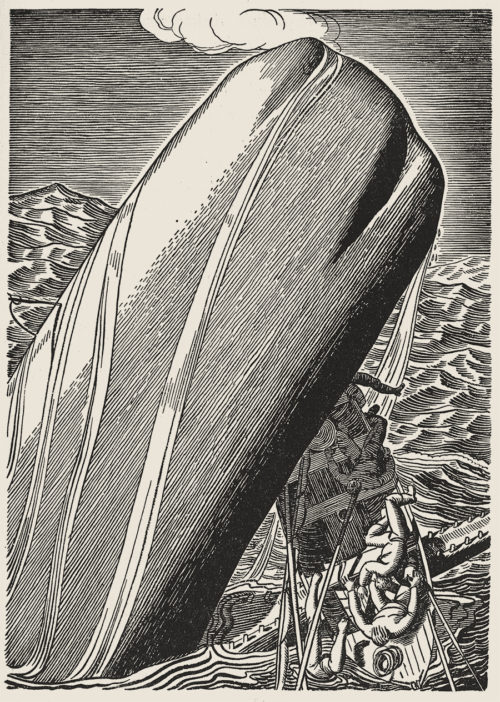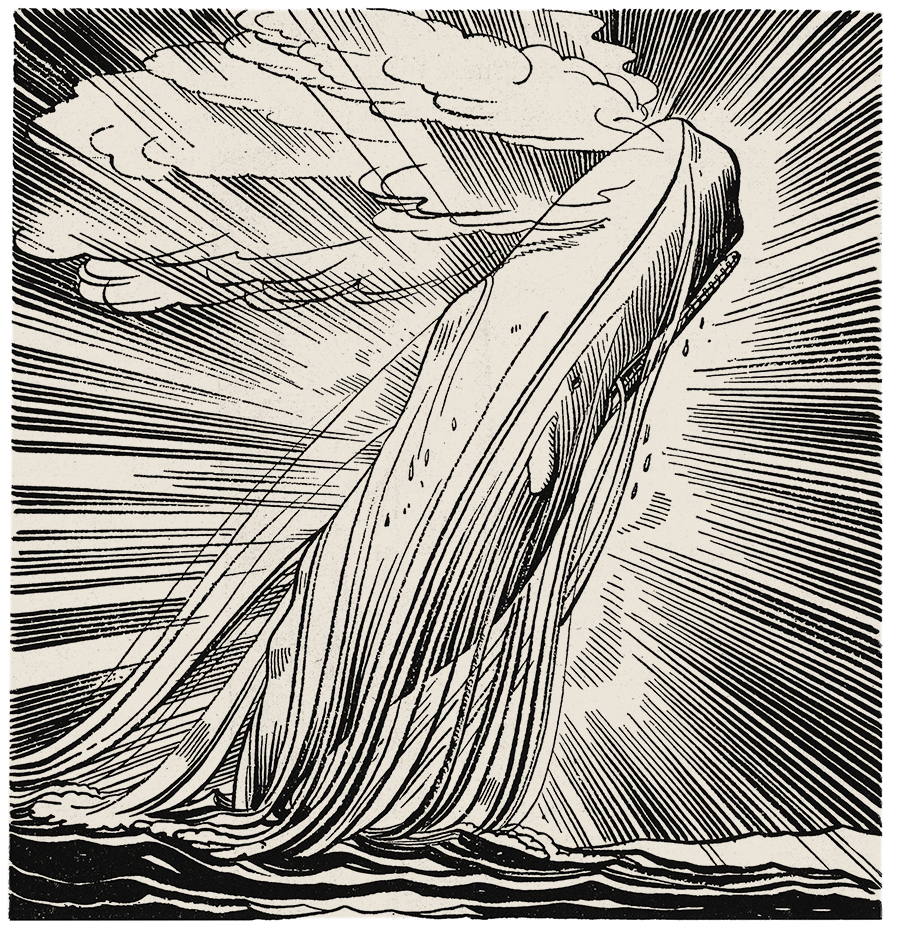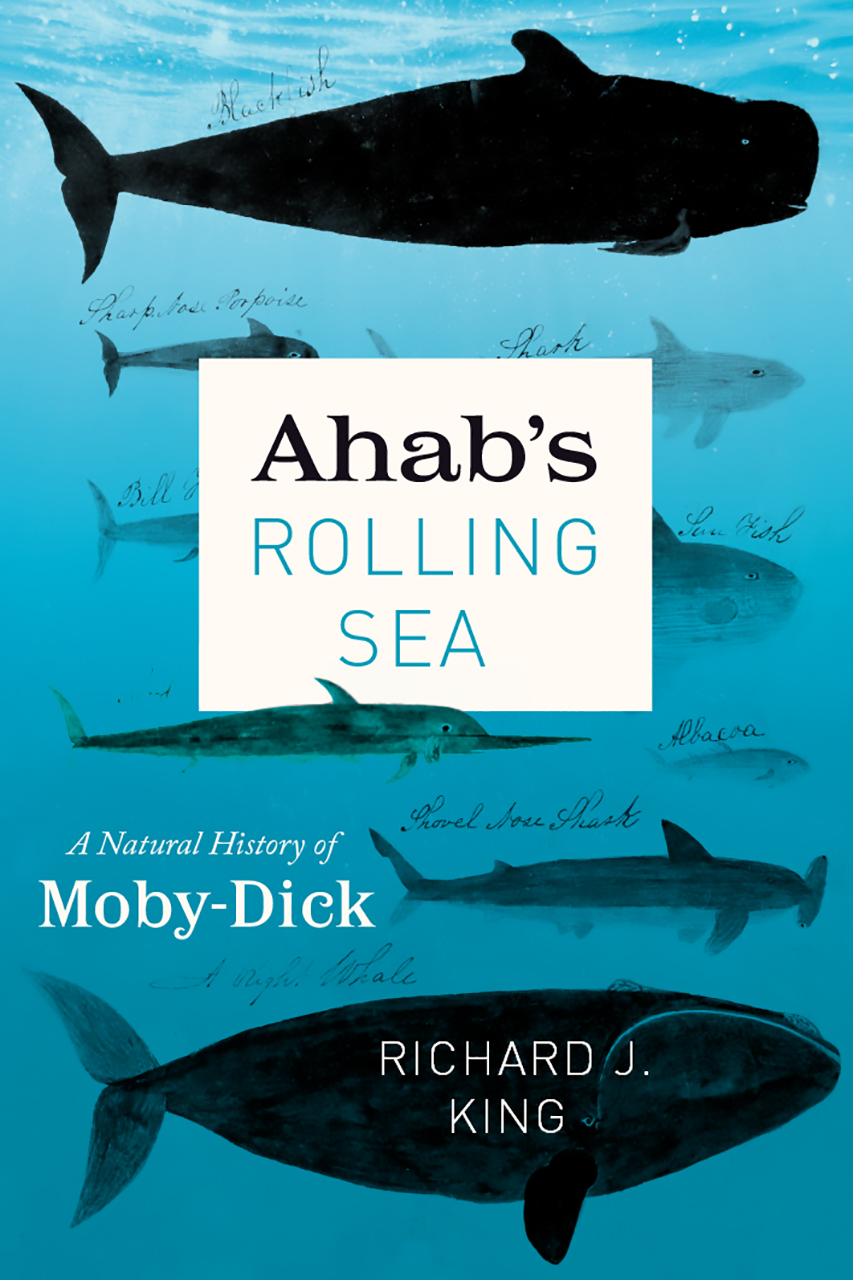Call Me Climate Refugee
How Moby-Dick's Ishmael Represents a Culture Soon To Be a Stateless Republic
By Richard J. King, author of Ahab’s Rolling Sea: A Natural History of Moby-Dick | Illustrations by Rockwell KentAt the end of the novel Moby-Dick, the infamous white whale smashes headfirst into the Pequod. The whaleship begins to sink. Aloft stands Tashtego, a Native American harpooner from Martha’s Vineyard, who accidentally nails the wing of a live frigatebird to the topmast above his head. The Pequod continues to sink. Tashtego is the last person drowned with the ship, taking the “bird of heaven” down with him.
IN HIS ATTEMPT TO HARPOON THE WHALE, Captain Ahab enrages the animal and ends up killing himself and his entire crew. The only one with the real legal power on the ship to stop Ahab is Starbuck, the first mate, who is unable, quite literally, to pull the trigger to stop Ahab’s mad, relentless pursuit of the whale. So Starbuck drowns with the rest.
It is only Ishmael, who, by fate or by chance, is flung out of Ahab’s small boat and beyond the sinking Pequod. As Tashtego takes his last breath, Ishmael, now a floating castaway, watches in powerless horror from afar. “The unharming sharks, they glided by as if with padlocks on their mouths,” writes Melville, and “the savage sea-hawks sailed with sheathed beaks.”
It is not until the next day that Ishmael is spotted from the masthead of another whaleship and rescued, to serve as the only living witness to the tragic journey.
Melville as Naturalist
In the summer of 2017, having read and taught Moby-Dick far too many times over the years, I stood aloft aboard the Robert C. Seamans, one of the oceanographic tall ships of the Sea Education Association (SEA) in Woods Hole, Massachusetts.
Perched some 100 feet above the deck, gazing down on the equatorial Pacific, I often thought about that closing drama and what a floating Ishmael might look like from a whaleman’s masthead view. I’d begged to teach this particular trip so I could sail in this region of the Pacific where I imagine Moby-Dick ends. I stood aloft at least two hours every day to look for whales, just as Melville would’ve done as a common whaleman during his three years in the Pacific aboard three different whaleships. I was researching the natural history of Moby-Dick, first published in 1851, with the idea to use this iconic American novel of the ocean as a benchmark for historical knowledge of marine biology, environmental history, and our cultural perception of the sea.
“I thought about Ishmael as a symbol of today’s climate refugee … the biblical orphan, representing a victim and a witness to events he had no power to stop.”
I dove deep into whalemen’s logbooks in libraries and into the vast and seemingly endless research by previous Melville scholars. I read narratives, novels, and journal articles that were published in Melville’s day, many of which we know he read himself. What I found is that Melville, through his narrator Ishmael, tried to be as careful as possible as to the details of the marine environment, accurately representing the knowledge of his time, and even occasionally correcting, if not outright mocking, theories and descriptions put forth by lubberly naturalists who had never been to sea themselves.
“A whale-ship was my Yale College and my Harvard,” Ishmael famously declares in Moby-Dick. He later adds to build on his authority: “I have swam through libraries and sailed through oceans; I have had to do with whales with these visible hands.”
The whaleman’s authority was earned. I do not believe there has ever been or will ever be another time in the history of the human race that we send so many people out to patiently and quietly observe the deep ocean environment in the way we did in the mid-1800s, when our appetite for light and machinery lubrication compelled tens of thousands of Americans, like Melville, to ship out to kill whales. At one point aboard his whaleship Acushnet, Melville spent more than six months meandering across the equatorial Pacific, not stopping in a single port and only anchoring a couple of times in the Galápagos.
Melville’s whaleships had no engine. He heard no generator or fan. He stood for two hours a day aloft, often alone, scanning for a splash, a spout, a fin, or perhaps a hunk of squid or a patch of plankton —because whalemen knew well what their prey ate. Theirs was a hunter’s knowledge, largely limited to superficial dissections, but it was careful, highly motivated, and built upon first-hand experience.

I’m not suggesting that ol’ Herman didn’t spin a fish story every once in a while or twist things here or there for the purpose of telling a mighty yarn, but over the last several years I’ve interviewed marine biologists and oceanographers to get their opinions on Moby-Dick, and I’ve been surprised to learn how many descriptions in the novel match our 21st-century knowledge.
For example, I turned to the University of Rhode Island Graduate School of Oceanography’s Bob Kenney, a right whale expert, to help me understand the nature of the plankton on which Ishmael’s right whales graze through in the Indian Ocean. Ishmael describes these whales feeding in a region where they were known to be common, and he perhaps describes a sound coming from the right whale’s baleen while skim-feeding, a “baleen rattle,” which was not described by the scientific community until the 1970s.
I interviewed URI’s Justin Richard, a beluga whale expert, to learn about Ishmael’s description of the whale’s spout. “Melville gets the spout mostly right,” Richard told me. “It’s not just mist. Like Melville said, part of it is the seawater that’s been sitting in the depression over the blowhole, which combines with this super powerful exhale, filled with carbon dioxide. This condenses with the outside air.”
Sperm whale biologists confirmed for me that all of the white whale’s behaviors in that final chase had been recorded at the time and have since been confirmed. And I spoke with two separate shark experts who explained to me that Ishmael’s gothic and graphic descriptions of sharks are actually surprisingly accurate, despite the authorial drama, right down to the cannibalism, the perfect circular holes the sharks chomp into whale carcasses, and even their disinterest in eating humans on purpose.
One afternoon while I was aboard the Robert C. Seamans, only a few days north of American Samoa, I was standing on deck after we conducted a man-overboard drill. We recovered a fender that Captain Chris Nolan threw over the side. Nolan, a former U.S. Coast Guard officer, explained to us just how quickly our little coconut heads would disappear in the waves, particularly if any kind of sea was running.
“Survivability is governed mostly by water temperature,” Nolan said. “In warmer waters, you can sometimes sur-vive up to 48 hours, or even longer. Even in 90-degree waters, like right around here, you’re still losing heat and you’ll get hypothermia. I’ve certainly heard of people surviving for days—the will to live is big in that. But if you’re in the water, you are going to die.”
After the drill, I asked Nolan about predators in the water, thinking about Ishmael’s “unharming sharks” at the end of Moby-Dick—if that was something for which the Coast Guard plans.
“No. There are no biological discussions in that training,” he said. “I think the sharks are more about curiosity. They are scavengers around bodies. I’ve never heard of any rescue of someone alive in the water where the rescuers had to fend off sharks.”

Ishmael as Climate Refugee
When I stood aloft that summer aboard the Robert C. Seamans, we sailed toward the equator and into the Phoenix Islands Protected Area, a gargantuan swath of the Pacific that is larger than some 130 Rhode Islands. This area was recently dedicated as a marine preserve by the government of Kiribati, which has been working with the New England Aquarium and SEA to conduct annual baseline oceanography.
Kiribati is one of the island nations in the Pacific that is most vulnerable to sea level rise. With about 100,000 citizens, it is on the front lines of climate change, the complex and cataclysmic global problem caused by nations and cultures half the world away.
While I was standing up there, swaying and watching the surface each day, I thought about Ishmael as a symbol of today’s climate refugee. The Kiribati people have begun planning for retreat from their islands because of the rapid loss of arable space and the pollution of their groundwater. They will almost certainly represent one of the first, if not the first, nations to be without a claim to home soil because of climate change.
For the first time in recorded human history, an entire culture will be a stateless republic of climate refugees. So even though Melville never intended this, I can’t help but read the end of Moby-Dick with Ishmael, the biblical orphan, representing a victim and a witness to events he had no power to stop.
Fittingly, the frigatebird is the national symbol of Kiribati, that same “sky-hawk” or “sea-hawk” (whalemen’s common names for this bird) that Tashtego takes down with him at the sinking of the Pequod—and the same seabird, along with the sharks, that permits Ishmael safe passage with “sheathed beaks” after Moby-Dick sinks the ship.
I still go aloft whenever I am teaching aboard the sea ships. I look for whales or anything else, just to try to connect to that quiet, deep-sea observation from aloft that is so difficult to replicate anywhere on Earth. And I remain struck by how accurate Melville was in terms of his marine biology, oceanography, and meteorology in Moby-Dick—from albatrosses to Zueglodons—as well as by how prescient he was in the earliest years of the Industrial Revolution.
He anticipated our future empathies for marine mammals and our paradoxical perception of the sea, which remains both inspiring and terrifying. Yet Melville in the 1850s could never have imagined our current goal of “saving the oceans”—our recognition of the need to steward the sea. In Moby-Dick, Ahab stands aloft and declares his ocean “The same!—the same!—the same to Noah as to me.”
How could Melville possibly conceive that humans could alter the global ocean? That we could alter the very height of the surface, shift the very chemistry of the entire sea, and that our actions could render heaven’s storms more intense? This was an impact too far beyond even Melville’s imagination—and our own. And so it goes today that our lack of national imagination results in our inability to collectively slow climate change.
Will the climate refugees and our descendants read us as Ahabs? Or more as Starbucks, the chief mate in Moby-Dick who has the power, but is unable to act?
All Rockwell Kent illustrations taken from the 1930 edition of Moby-Dick by The Lakeside Press.
© Rights courtesy of Plattsburgh State Art Museum, State University of New York, USA, Rockwell Kent Collection, Bequest of Sally Kent Gorton. All rights reserved.
Richard J. King is the author of Ahab’s Rolling Sea: A Natural History of Moby-Dick, a chronological journey through the natural history of Herman Melville’s beloved and literary classic Moby-Dick.
King examines what Melville knew from his own experiences and the sources available to a reader in the mid-1800s, exploring how and why Melville might have twisted what was known to serve his fiction.
Contact Us
Telephone: (401) 874-6805
Email: allard@uri.edu
Contributor Guidelines
Please review submission guidelines to be considered. d


